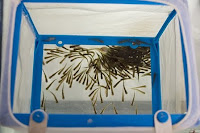
On December 7, the Virginia Museum of Natural History (VMNH) received its first batch of brown trout eggs. The estimated 488 trout eggs resembled translucent pink marbles with eyes. The new additions were approximately two weeks old and loaded into the safety basket inside the tank. Brian Williams of Dan River Basin Association (DRBA) delivered the eggs from the Virginia Department of Game and Inland Fisheries (DGIF) Hatchery in Wytheville, VA.
Currently, the eggs have hatched and are now referred to as "alevins." Alevins resemble a small tadpole with a bulging yolk sac. They have a tail that allows them to move freely inside the safety basket. In the wild, eggs have a 1% survival rate. In our tanks, along with those in classrooms, the eggs have a 25% survival rate. Streams in the wild contain predators and hazards to developing trout eggs. The tanks provide an environment free of the outside challenges that trout eggs encounter. Also, water quality is monitored and regulated in the tanks, unlike streams in the outdoors. The alevin trout will remain in the safety basket, nourished by the remaining yolk sac. In 2-3 weeks, the alevins will have used up their yolk sac and rise to the top of the safety basket. Eventually, they will swim over the basket and into the expanse of the tank.





